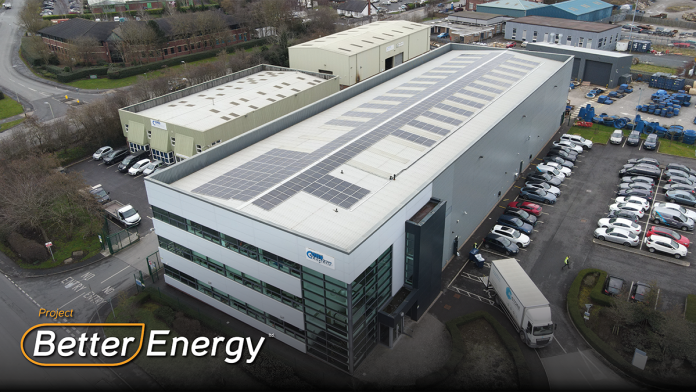How can we provide renewable technology solutions to help companies meet the 2050 net zero deadlines and have improved EPC rating legislation? Gavin Cunjamalay at Project Better Energy explores this here
The UK government has planned a roadmap towards becoming a net zero country by 2050, meaning that carbon emissions as a country need to equal the amount of carbon we remove from the atmosphere. Major infrastructure decisions need to be made shortly and quickly implemented. These changes are unprecedented in their overall scale, but large-scale transitions have been achieved successfully in the UK before, such as the natural gas switchover in the 1970s or the switch to digital broadcasting in the 2000s, and now, bettering energy efficiency with improved EPC ratings.
Changes in commercial EPC rating legislation
An EPC rating is a document used to indicate a property’s level of energy efficiency. Businesses are provided with a commercial EPC. This rates their efficiency from ‘A’ (very efficient) to ‘G’ (inefficient). An energy efficiency report also includes recommendations on ways a property can be improved to cut fuel bills, improve efficiency, and reduce carbon emissions.
The Government are imposing legislation in an effort to make commercial buildings more economically efficient, to help the UK progress towards a net zero economy. These regulations will be mandatory, resulting in large fines for companies that do not meet the criteria. Modern renewable energy technologies provide a well-rounded approach to lowering a business’s EPC rating.
Commercial EPC timeline
Since 2018, the minimum energy efficiency standard for commercial property is E, meaning it is unlawful to grant a new tenant, in a property with an EPC rating of F or G.
By 2027, the government expects all commercial rented buildings to have improved the building to an EPC rating of at least a C or register a valid exemption.
And in 2030, it will be unlawful to continue to let a commercial property with an EPC rating of below a B.
Commercial solar systems with no upfront cost!
In a push towards becoming a Net Zero nation, there has been increased pressure on raising EPC ratings. By 2027, Landlords need an EPC rating of ‘C’ or higher and a ‘B’ by 2030, along with all other commercial premises.
Project Better Energy (PBE) makes the adoption of solar technology even more accessible, with free solar through a Power Purchase Agreement. Meaning any eligible business can start its clean energy journey, without putting capital at risk.
This system will be maintained, free of cost, for up to 15 years – with the company buying electricity from PBE for a discounted rate, with a 4% index increase per annum.
Depending on the PPA model chosen, after 15 or 25 years, the system ownership will be given to the company, where they can utilise the full benefits of the system, without ever paying.
Solar Systems, regardless of how they are purchased, can turn excess energy into carbon credits – which can be used to offset carbon. This can play a vital part in meeting a company’s sustainability policies and reaching net zero. These credits can also be traded for a profit, to companies who need support in reaching their net-zero targets. Project Solar, part of the Project Better Energy group, offers both commercial and domestic Solar Solutions.
Commercial off-peak power store: moving towards energy independence
Energy prices in the UK are rising and set to rise even further, with both companies and homes feeling the financial squeeze and the heavy burden of poor EPC ratings.
Although solar can generate free energy from the sun to help mitigate energy costs, power storage can have a key role in the optimisation of this energy.
Systems that generate surplus energy, can store it to be reused at peak energy times to result in a lower average energy cost.
Power Stores can also make use of off-peak energy tariffs such as Economy 7 through force charging from the grid when the prices are low, for usage during peak times.
Alternatively, excess energy can be traced back to the grid at times when energy cost is at its highest, turning power stores into a revenue stream.
Project Solar, part of the Project Better Energy group, offers both commercial and domestic power storage solutions.
Commercial electric vehicle charging solutions: prepare for the ban on tailpipe emissions!
Before the ban on tailpipe emissions for new vehicles in 2035, the UK needs to rapidly adopt not only electric vehicles but a reliable charging network, using both private and public charging outlets.
To ensure that the charging network is of high quality, the government passed smart compliance legislation to maintain cyber security, anti-tampering, grid protection, and a set of mandatory features.
Electrifying your vehicle or fleet of vehicles Before the ban on tailpipe emissions for new vehicles in 2035, the UK needs to rapidly adopt not only electric vehicles but a reliable charging network, using both private and public charging outlets. To ensure that the charging network is of high quality, the government passed smart compliance legislation to maintain cyber security, anti-tampering, grid protection, and a set of mandatory features. Electrifying your vehicle or fleet of vehicles can drastically lower a company’s carbon footprint and can save money on every journey, along with lower maintenance costs than its combustion-powered competitor’s. This can be combined with a Solar & Power Storage system to charge a vehicle for free.
Project EV, part of the Project Better Energy group, offers a variety of EV charging solutions that are suitable for both domestic and commercial applications ranging from 7.3kW up to 360KW.

This work is licensed under Creative Commons Attribution-NonCommercial-NoDerivatives 4.0 International.











